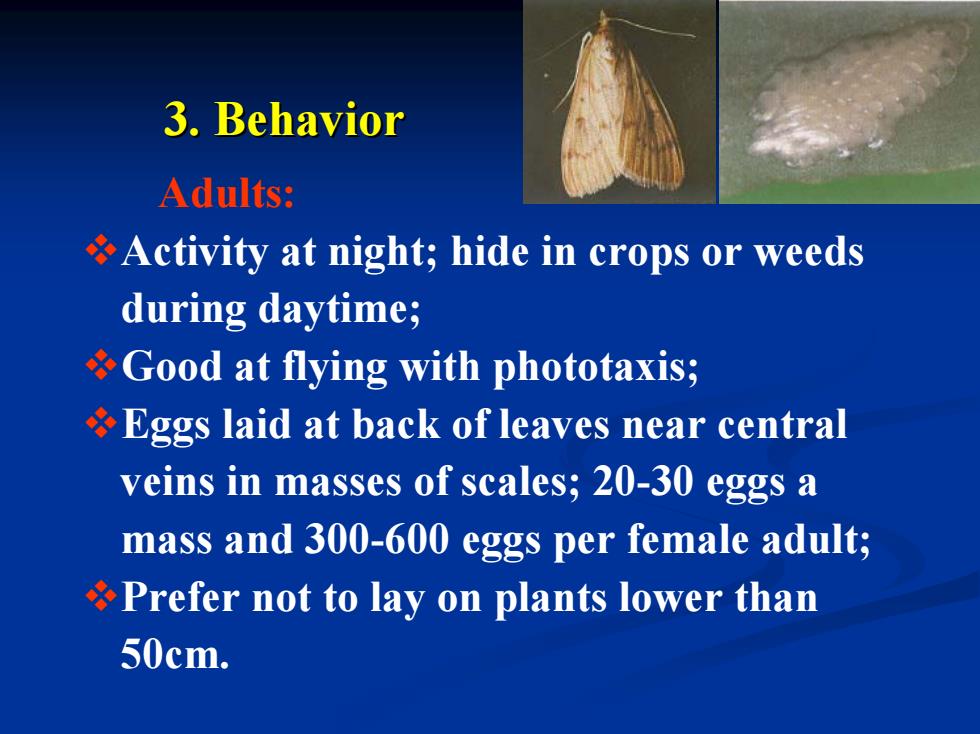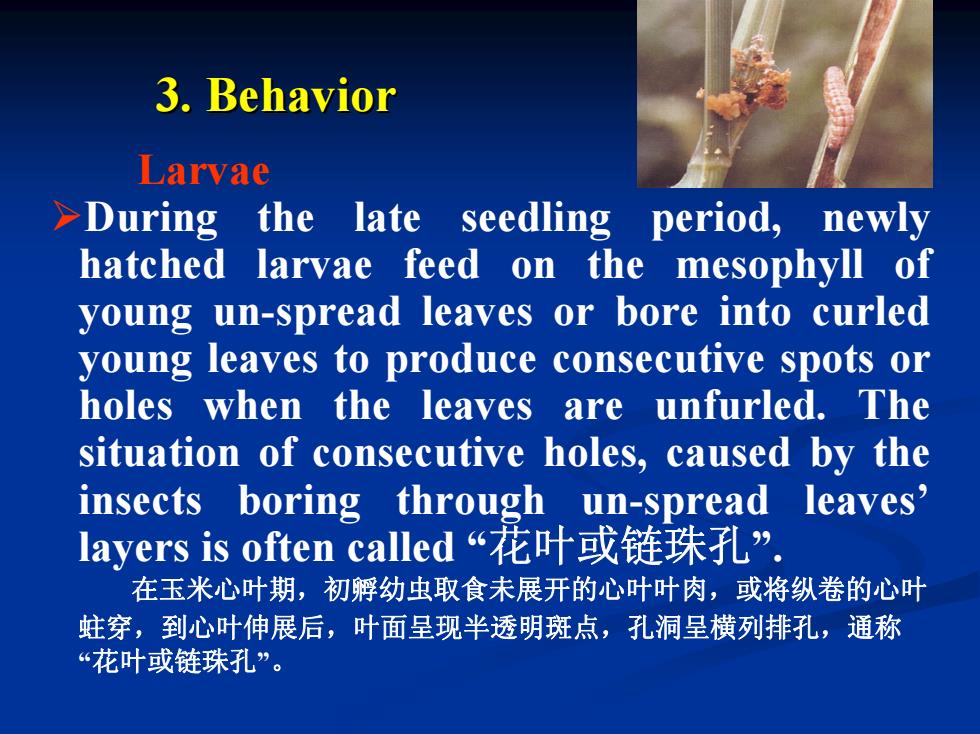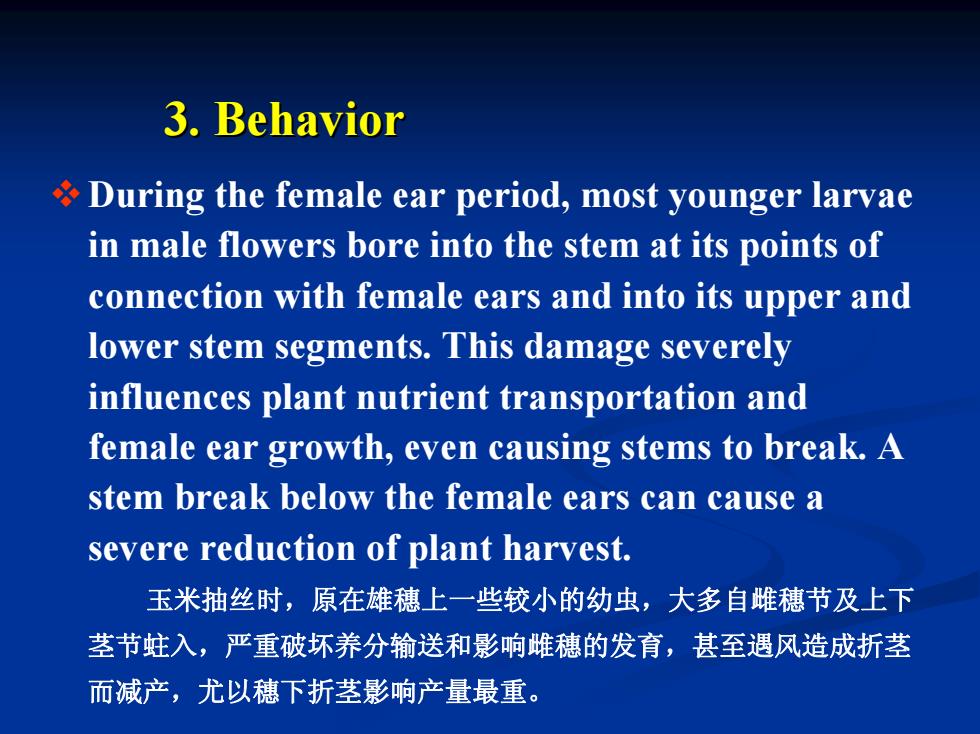
3.Behavior Adults: *Activity at night;hide in crops or weeds during daytime; *Good at flying with phototaxis; *Eggs laid at back of leaves near central veins in masses of scales;20-30 eggs a mass and 300-600 eggs per female adult; Prefer not to lay on plants lower than 50cm
Adults: Activity at night; hide in crops or weeds during daytime; Good at flying with phototaxis; Eggs laid at back of leaves near central veins in masses of scales; 20-30 eggs a mass and 300-600 eggs per female adult; Prefer not to lay on plants lower than 50cm. 3. Behavior 3. Behavior

3.Behavior Larvae Newly hatched larvae crawl quickly to spread out or spin silk to move to other plants; >Prefer sugar and moisture,but don't like light;
Larvae ¾ Newly hatched larvae crawl quickly to spread out or spin silk to move to other plants; ¾ Prefer sugar and moisture, but don’t like light; 3. Behavior 3. Behavior

3.Behavior Larvae >During the late seedling period, newly hatched larvae feed on the mesophyll l of young un-spread leaves or bore into curled young leaves to produce consecutive spots or holes when the leaves are unfurled.The situation of consecutive holes,caused by the insects boring through un-spread leaves' layers is often called“花叶或链珠孔”, 在玉米心叶期,初孵幼虫取食未展开的心叶叶肉,或将纵卷的心叶 蛀穿,到心叶伸展后,叶面呈现半透明斑点,孔洞呈横列排孔,通称 “花叶或链珠孔
Larvae ¾During the late seedling period, newly hatched larvae feed on the mesophyll of young un-spread leaves or bore into curled young leaves to produce consecutive spots or holes when the leaves are unfurled. The situation of consecutive holes, caused by the insects boring through un-spread leaves’ layers is often called “花叶或链珠孔”. 在玉米心叶期,初孵幼虫取食未展开的心叶叶肉,或将纵卷的心叶 蛀穿,到心叶伸展后,叶面呈现半透明斑点,孔洞呈横列排孔,通称 “花叶或链珠孔”。 3. Behavior 3. Behavior

3.Behavior *Before the male flower appears,most larvae either bore into the stems of male flowers to break the male flowers,or bore into plant stems above female ears. 在雄穗出现前,幼虫大多蛀入雄穗柄内,造成折雄,或蛀入雌 穗以上节内
Before the male flower appears, most Before the male flower appears, most larvae either bore into the stems of male larvae either bore into the stems of male flowers to break the male flowers, or bore flowers to break the male flowers, or bore into plant stems above female ears. into plant stems above female ears. 在雄穗出现前,幼虫大多蛀入雄穗柄内,造成折雄,或蛀入雌 穗以上节内。 3. Behavior 3. Behavior

3.Behavior *During the female ear period,most younger larvae in male flowers bore into the stem at its points of connection with female ears and into its upper and lower stem segments.This damage severely influences plant nutrient transportation and female ear growth,even causing stems to break.A stem break below the female ears can cause a severe reduction of plant harvest. 玉米抽丝时,原在雄穗上一些较小的幼虫,大多自雌穗节及上下 茎节蛀入,严重破坏养分输送和影响雌穗的发育,甚至遇风造成折茎 而减产,尤以穗下折茎影响产量最重
During the female ear period, most younger larvae in male flowers bore into the stem at its points of connection with female ears and into its upper and lower stem segments. This damage severely influences plant nutrient transportation and female ear growth, even causing stems to break. A stem break below the female ears can cause a severe reduction of plant harvest. 玉米抽丝时,原在雄穗上一些较小的幼虫,大多自雌穗节及上下 茎节蛀入,严重破坏养分输送和影响雌穗的发育,甚至遇风造成折茎 而减产,尤以穗下折茎影响产量最重。 3. Behavior 3. Behavior